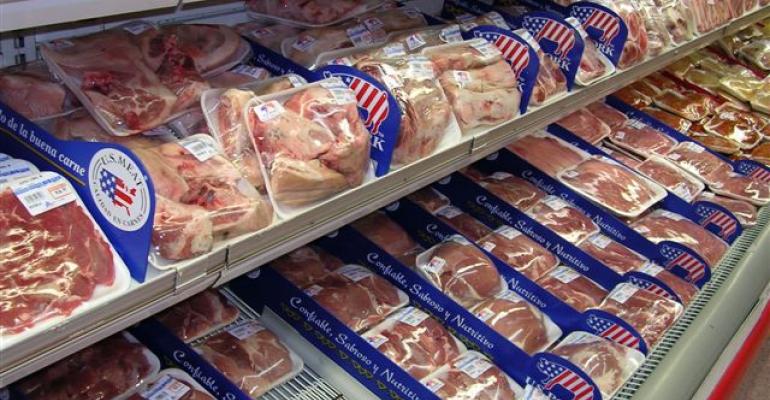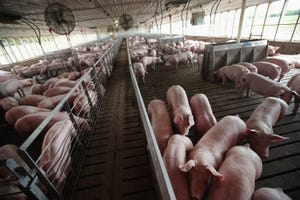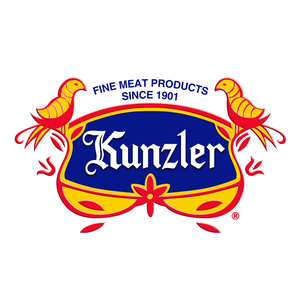Market access obstacles take toll on first quarter pork exports
First quarter exports were 6% below last year’s pace in volume (600,268 mt) and down 14% in value ($1.47 billion).
May 13, 2019

For the first quarter of 2019, U.S. pork exports continued to be slowed by trade barriers, while beef exports were just slightly below last year's pace and lamb exports trended significantly higher than a year ago, according to March data released by USDA and compiled by the U.S. Meat Export Federation.
Pork exports totaled 211,688 metric tons in March, down 7% from a year ago, valued at $520.7 million (down 15%). First quarter exports were 6% below last year’s pace in volume (600,268 mt) and down 14% in value ($1.47 billion).
Pork export value averaged $48.55 per head slaughtered in March, down 15% from a year ago. For January through March, export value averaged $46.15 per head, down 16% from the first quarter of 2018. March exports accounted for 25.6% of total U.S. pork production and 22.7% for muscle cuts only – down from 27.5% and 23.5%, respectively in March 2018. First quarter exports accounted for 24.4% of total pork production (down from 26.6%) and 21.3% for muscle cuts (down from 23%).
Since mid-2018, most U.S. pork entering Mexico has faced a 20% retaliatory duty imposed in response to U.S. tariffs on steel and aluminum imports. This turn of events ended six consecutive years of record export volumes to Mexico, and early 2019 is showing no signs of relief. First quarter exports to Mexico were down 13% year-over-year in volume (177,420 mt) and sank 29% in value ($261.9 million). The U.S. is still Mexico’s primary supplier of imported pork but Canada, Chile and the European Union have gained market share in 2019 and Mexico’s domestic pork production is trending significantly higher.
U.S. pork also faces retaliatory duties in China, raising the total tariff rate from the normal 12% to 62%. This will make it difficult for U.S. pork to capitalize on any increase in China’s demand for imported pork, which analysts are projecting in the second half of 2019 and beyond, due to the spread of African swine fever. Through March, U.S. exports to the China/Hong Kong region were 20% below last year’s pace in volume (89,689 mt) and down 34% in value ($172.1 million).
Leading value market Japan has not imposed any new tariffs on U.S. pork, but U.S. exports are at a disadvantage compared to pork from the European Union, Canada and Mexico due to their new trade agreements with Japan. As with beef, this gap will widen unless the U.S. and Japan reach a trade agreement. Through the first quarter, U.S. exports to Japan were 9% below last year’s pace in volume (92,503 mt) and 11% lower in value ($374.9 million).
“The current environment for U.S. pork is a good illustration of why it has been such a high priority for the U.S. industry to develop a wider range of international destinations,” says Dan Halstrom, USMEF president and CEO. “Though we absolutely must get back on a level playing field in Mexico, China and Japan, larger exports to emerging markets have offset some of the decline.”
First quarter highlights for U.S. pork include:
Continued strong growth in Colombia and a large increase in shipments to Chile and Peru pushed exports to South America 41% above last year’s record pace in volume (40,998 mt) and 40% higher in value ($99.3 million).
Exports to Central America and the Dominican Republic also continue to exceed the record pace of 2018. Strong growth in Guatemala, Costa Rica and Panama along with continued growth to top market Honduras pushed exports to Central America 12% higher in volume (20,903 mt) and 7% higher in value ($48.1 million). Export volume to the Dominican Republic increased 15% to 10,969 mt while value was up 13% to $24.2 million.
Oceania is a key market for hams and other muscle cuts destined for further processing, and first quarter exports increased significantly to both Australia and New Zealand. Export volume to the region was up 31% from a year ago to 30,070 mt while value increased 14% to $78.6 million.
Exports to Taiwan surged 83% in volume (6,584 mt, the highest first quarter since 2011) and 57% in value ($14.3 million). U.S. pork has been limited in Taiwan by a zero-tolerance policy for beta agonists, but exports have still trended higher over the past two years. In 2019, the U.S. is the only major pork supplier reporting larger exports to Taiwan.
Beef exports to Korea still red-hot; Japan cools slightly in March
March beef exports totaled 107,655 mt, down 4% year-over-year, while value fell 2% to $678 million. For the first quarter, exports were down 3% at 307,306 mt valued at $1.9 billion (down 0.8%).
March beef exports were very strong on a per-head basis, with export value per head of fed slaughter averaging $335.81 – up 1% from a year ago and the highest since December. The first quarter average was $309.32/head, down 2% from a year ago. March exports accounted for 13.6% of total U.S. beef production and 11% for muscle cuts only, which was fairly steady with last March. For the first quarter these ratios were 12.9% and 10.2%, down from 13.2% and 10.7%, respectively, a year ago.
South Korea continues to be the growth leader for U.S. beef exports, with first quarter volume climbing 8% year-over-year to 56,173 mt, while value ($414.2 million) was 13% above last year’s record-shattering pace. U.S. beef has achieved remarkable success in Korea’s traditional retail and restaurant sectors but is also rapidly gaining popularity in outlets such as convenience stores and e-commerce platforms. Recent export growth is not only in the ever-popular short rib category, but also in short plate, briskets, clods and rounds, as end-users recognize the versatility and affordability of high-quality U.S. beef.
Beef exports to Japan were moderately lower than a year ago in March, but still finished the first quarter 2% above last year’s pace in volume (74,147 mt) and 5% higher in value ($480.4 million). This was fueled by growth in variety meat exports, with the U.S. shipping more tongues and skirt meat to Japan. U.S. beef faces a widening tariff disadvantage in Japan compared to imports from Australia, Canada, New Zealand and Mexico, and the latest tariff reduction for these countries didn’t take effect until April 1.
“U.S. beef cuts are still subject to a 38.5% tariff in Japan while our competitors’ rate is nearly one-third lower at 26.6%,” says Halstrom. “This really underscores the urgency of the U.S.-Japan trade negotiations, which must progress quickly if we are going to continue to have success in the leading value market for U.S. beef and pork.”
Japan’s tariffs on beef variety meat are lower, but U.S. shipments are subject to a duty of 12.8% while competitors pay less than half that rate.
Other first quarter highlights for U.S. beef include:
Beef muscle cut exports to Mexico continued to shine, with first quarter volume up 14% from a year ago to 35,481 mt and value climbing 16% to $220.7 million. While variety meat exports trended lower year-over-year, combined beef/beef variety volume still increased 1% to 57,591 mt while value jumped 12% to $280.2 million.
Exports to Taiwan were 3% above last year’s record pace at 13,487 mt, though value slipped 7% to $117.8 million. U.S. beef dominates Taiwan’s chilled beef market with nearly 75% market share – the highest of any Asian destination.
CAFTA-DR markets continue to be an excellent source of growth for U.S. beef exports, with first quarter volume to Central America up 15% from a year ago to 3,628 mt and value up 19% to $21.2 million. Exports to the Dominican Republic soared 71% to 2,345 mt valued at $18.9 million (up 65%).
Lower exports to Hong Kong and Canada offset some of the first quarter growth in other markets. Exports to Hong Kong trailed last year’s pace by 36% in volume (21,304 mt) and 30% in value ($177.1 million). Exports to Canada were down 14% in both volume (23,199 mt) and value ($143.8 million).
U.S. exports to China were up 4% from a year ago to 1,723 mt, but this came at lower prices as export value fell 17% to $13.2 million. There is tremendous potential in the Chinese market for U.S. beef, but due to China’s restrictive import requirements and retaliatory duties pushing the tariff rate to 37%, U.S. prices are significantly higher than the competition. By comparison, most beef suppliers are subject to a 12% tariff in China while beef from New Zealand is duty-free and Australian beef pays only a 6% rate. Australia’s grain-fed beef exports to China in the first quarter totaled 14,347 mt, up 77% year-over-year.
Demand for U.S. lamb still climbing
Fueled by strong variety meat demand in Mexico and strong muscle cut growth in the Caribbean, the Middle East and Central America, U.S. lamb exports posted a solid first quarter. Exports increased 68% in volume to 4,173 mt while value was up 29% to $6.9 million. For muscle cuts only, exports were lower year-over-year in March, but first quarter exports still increased 25% in volume (659 mt) and 19% in value (just over $4 million).
Source: USMEF, which is solely responsible for the information provided, and wholly owns the information. Informa Business Media and all its subsidiaries are not responsible for any of the content contained in this information asset.
About the Author(s)
You May Also Like

.png?width=300&auto=webp&quality=80&disable=upscale)

